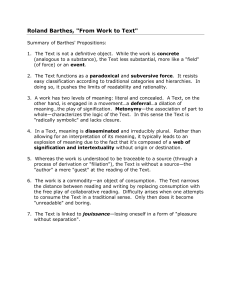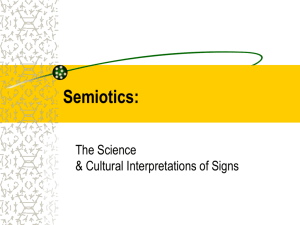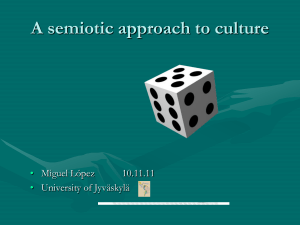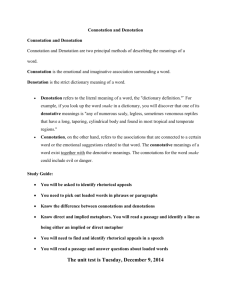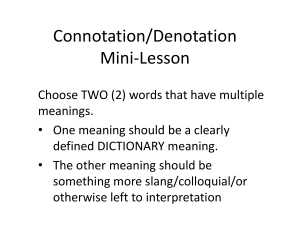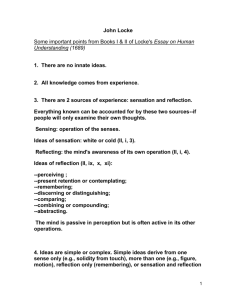Semiotics: Roland Barthes
advertisement
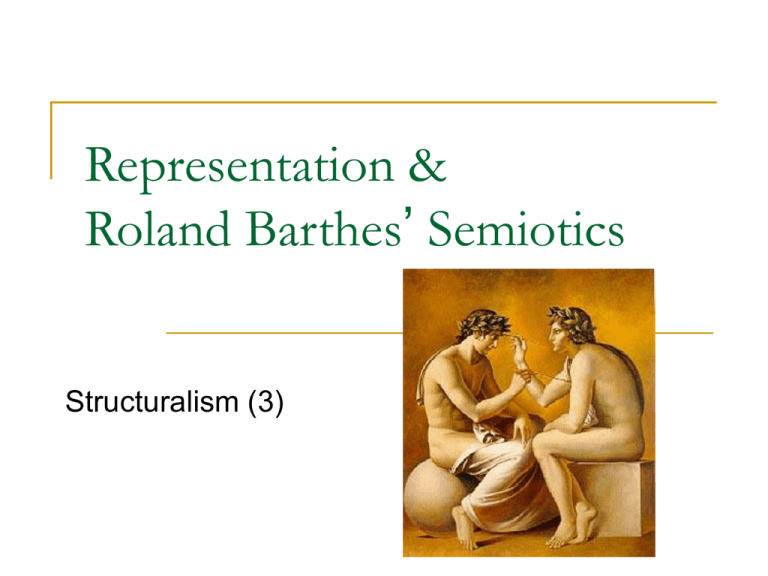
Representation & Roland Barthes’ Semiotics Structuralism (3) Outline 1. Representation 2. Semiotics: Representation and Production of Meaning Theories of Representation De Saussure Re-Considered: Contribution & Limitations Major principles in semiotic readings Sign systems: fashion as an example Semiotic reading (1): denotation and connation Semiotic reading (2): first and second-order signification. (literal language and meta-language) Myth today defined 3. Examples: Images of Nature in some Landscape Paintings and Ads What is Representation? 1. 2. 3. Not Re-Presentation (原音重現,身歷其境, 歷史現 身) “Representation means using language to say something meaningful about, or to represent, the world meaningfully, to people.” (15) Using language (system of representation); To produce meanings (another system of representation) about (make connections among) things, and To communicate them to some people. What are the two systems of representation we use in representation (meaning production)? 1. Signs Codes (pp. 21-22) signifier (e.g. ‘love’ ‘I’) 2. Conceptual System (pp. 17-18; e.g. love ‘romantic love,’ ‘puppy love,’ ’maternal love,’ etc.) frequently inseparable from the signified of our languages; What’s hidden in this stereogram Shapes formed because of 1) twoeye differences (wall-eyed; crosseyed); 2) the gestalt laws of organization (e.g. figure and ground) Conceptual System What’s hidden in this stereogram ANSWER: BUNNY! http://www.billybear4kids.com/stereogram/bunny.html What’s this? What mental image (concept) does it correspond to? Different Perspectives = Different Conceptual Systems the Context of a sign, which determines its meaning 1. Conceptual System = 2. Sign system– image or English letters Two Systems at Work in Representation: What kind of room is this? A restaurant or a tea house? Signs: Red color, paper lantern, floor-to-ceiling windows, sofas, pillows, wood desk, ‘bamboo room,’ etc. What kind of room is this? The Lava Room From Star Nightclub http://www.creamnyc.com/ Representation= Meaning Production What makes the difference? Different Languages Are these meanings absolute or relational? Why? Meaning – Essential or Relational? I Think I’m Happy God Loves Me 1. “I” – no essence? 2. Meanings – one truer/better than the other? –produced by ourselves or a system? AM II AM I Teach/ Contribute to Society I Fuck/ Produce Children I Shop 生活的意義在 增進人類全體的生活﹔ 生命的意義在 創造宇宙繼起的生命。 * Note Note: Relativism Is there an essential definition of our selves? e. g. 生為中國/劉家/輔大人,死為中國/劉家/輔 大魂(鬼﹚。 Self(-Definition) –not essential nor unchangeable; -- is relational (“I am A” implies “I am not B”). (i.e. binarist thinking may be at work.) -- is usu. determined by our value systems, if not given to or imposed on us by our society. -- can be contradictory, with so many conceptual systems we live in. Relational view of meaning is not relativism. Relativism: Everything is ok and nothing matters. Theories of Representation Reflective approach – Intentional approach – Can we decide the meanings of what we say? (p. 25) Some truth and functions to it (in communication, in knowledge acquisition) Representation as “Re-Presentation” Representation as Self-Expression (得意而忘言;言止於心 意深處) Constructivist approach – Things don’t mean; we construct meanings about them by using different systems of representation. Representation as Construction: We don’t speak language; language speaks us. (Activity 4) De Saussure: Contribution & Limitations (pp. 32 – 35) Contributions to the Constructionist Theory of Representation Arbitrary relations between signifier and signified Meanings in language can never be fixed; they are open to changes by ‘context’ (historical, social or personal). Langue vs. parole the social part of language; Limitations: too exclusive focus on language; Language is not a closed system. semiotics –the study of signs (languages in a broader sense) Semiotics & Roland Barthes Major principles All the cultural products and activities read as process or results of signification. No meaning is inherent or natural. 2. There are more than one (arbitrary) relations between signifiers and signified. (iconic --resemblance, indexical --cause, symbolic -- arbitrary). 3. There are more than one level of meanings. denotation and connotation. 1. What kinds of signs are they? indexical Iconic Symbolic = Church = crossroad = airport Sign System: Fashion as an Example Fashion codes (signs + concepts) (Textbook pp. 37-38) Fabric: Silk= feminine, denim= masculine, casual, cotton = comfortable, khaki= military, formal. skirt (+ silk)= feminine; jeans (+ cotton TShirt) =casual or masculine Sign System: Rules of Selection and Combination All social practices as sign-systems and thus are open to cultural interpretation (or de-mystification). e.g. the meaning of a jacket defined by its contexts. e.g. the “langue” of clothes (selection & combination) System: a. blouse, shirt, T-shirt ; b. skirt, trousers sentence: 1. blouse + skirt + high heeled shoes X snickers 2. blouse + jeans + snickers X not for concert Fashion and Myth: from denotation to connotation; description to prescription “. . . Mist gold, pure gold, and black gold are all flashing in full glamour since most collections are heavily weighted toward evening cloths with an ostentatious dressing chic. If gold is too much for you, don’t worry, for here comes the backup that makes you in style as well, the color of camel! As usual, camel has always been playing its role of warming up the winter, which has been so elegantly carried out by the blazing gold as it is this year. “ (Sophie Ko) Fashion: from language to myth “Leather, of course, is something that can’t be left out in each winter.” “Fur, for sure, is a must, especially for collars, ” “As for trousers, they really do need to be slimfitting and skinny-legged to be chic this season! ” (Sophie Ko) myth: 紫醉金迷、世紀末的華麗 Semiotic reading (1): Denotation and Connotation e.g. Panzani pasta 1. Denotation: “the real objects in the scene” The signifiers: “these same objects photographed.” 2. Connotation: “half-opened bag” spilling out onto the table freshness, the domestic 3. Italianness (red green white) 4. ‘a total culinary service” 5. Arrangement like “still life” painting Semiotic reading (2): Different levels of signification: primary signification & secondary signification a signifier + signified = sign (full)--denotation primary signification: Secondary signification Sign (empty)/ Form + content = sign --connotation Semiotic reading (2): Different levels of signification: primary signification & secondary signification Signifier + signified = ([home]) sign (full)--denotation primary signification: Secondary signification Barthes’ examples: rose, black pebble. Sign (empty)/ Form + content = sign --connotation: Homepage, country cottage, etc. Myth colonialism militariness Signifier + signified = Young negro, in uniform, saluting, With eyes uplifted, fixed on the tricolor sign (full)—denotation ([Black solider saluting a French flag]) Patriotism/submission primary signification: Secondary signification Sign (empty)/ Form + content = sign --connotation: France as a Great empire, loved by all her “sons.” “Myth”: distortion, naturalizing The form(on the secondary level) does not suppress the original meaning, it only impoverishes it, it puts it at a distance... myth hides nothing: its function is to distort, not to make disappear Target: Myth has an imperative, buttonholing character: ...it is I whom it has come to seek. ... For this interpellant speech is at the same time a frozen speech: at the moment of reaching me, it suspends itself, turns away and assumes the look of a generality; it stiffens, it makes itself looks natural and innocent
